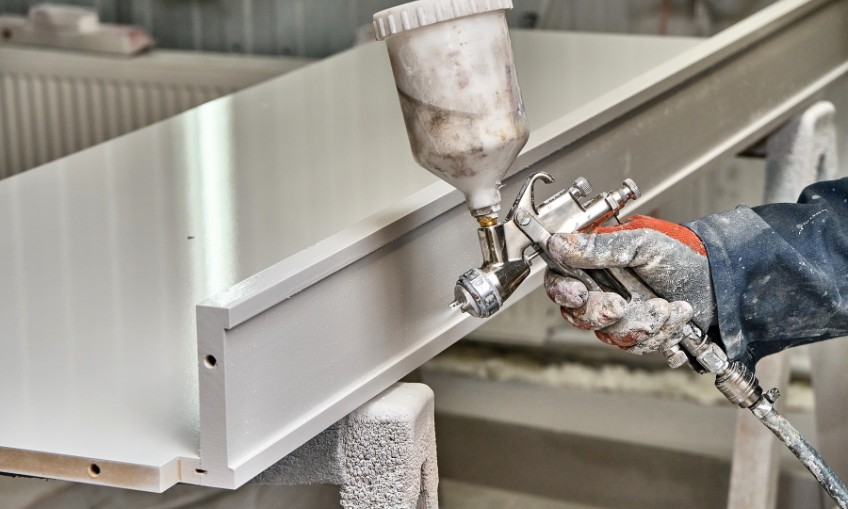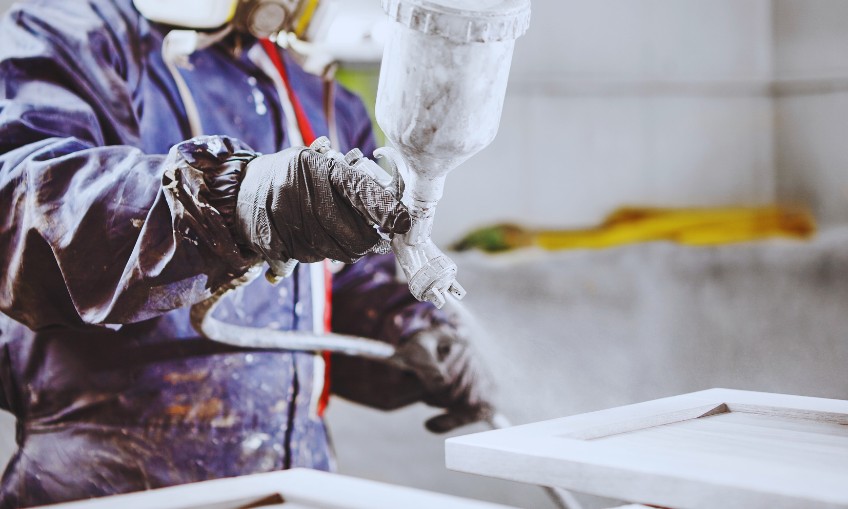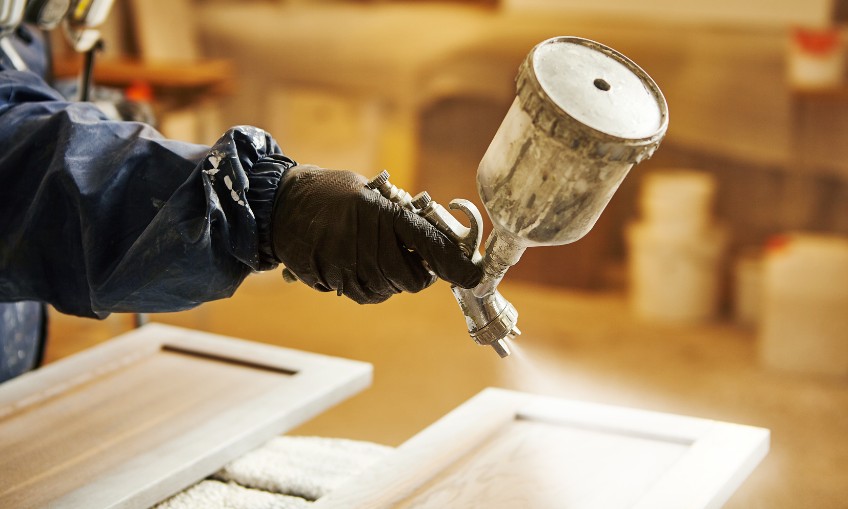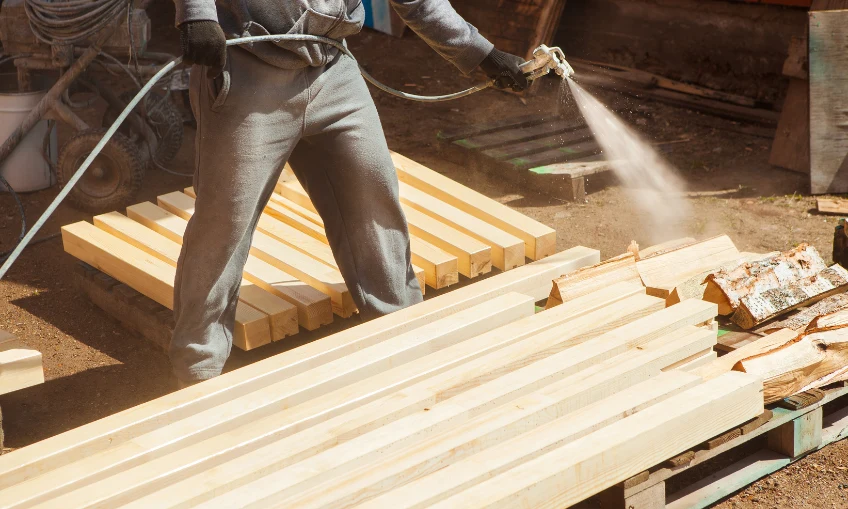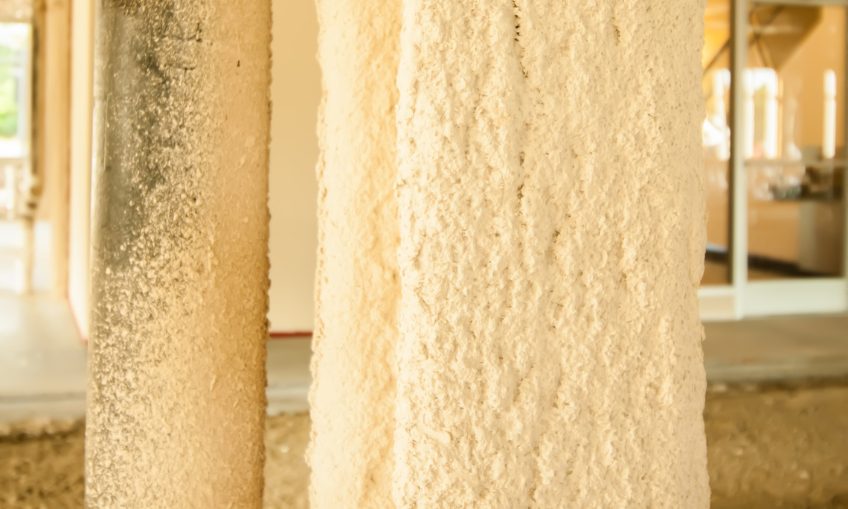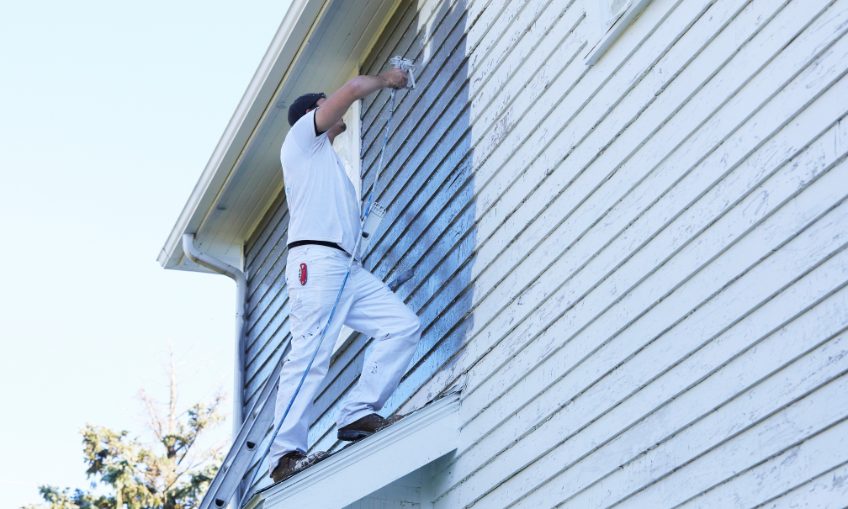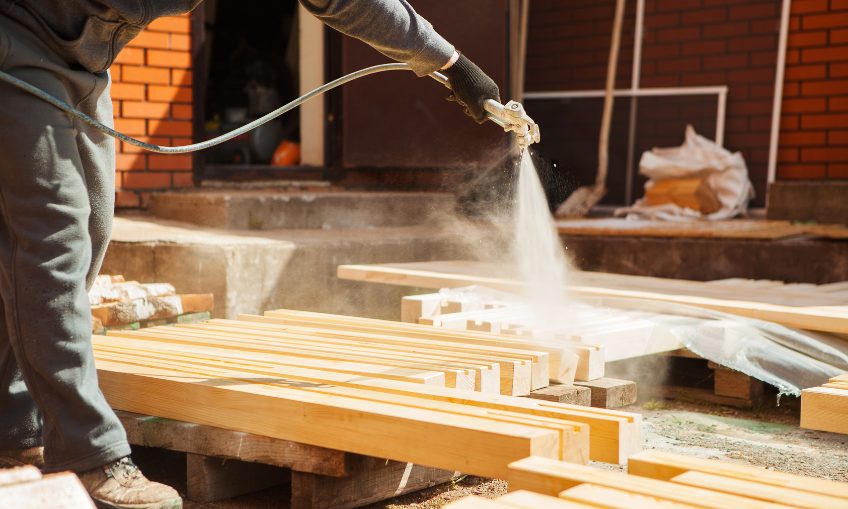Steel is a well-known material for its strength and durability in architecture and construction projects. However, steel’s susceptibility to high temperatures and fire is a significant challenge. This is where intumescent coatings come into play as a critical solution for enhancing the fire resistance of steel structures. These coatings, also known as intumescent paints, are a simple and effective way to protect the essential parts of a building, like columns, beams, floors, and roofs, from fire.
This coating helps keep the building from collapsing during a fire by insulating these structural elements. It provides the building with a certain amount of time to resist fire, which is crucial for safety. In this blog, we will discuss how they work, their applications, and considerations for use in construction. Let’s discuss it in detail!
How Is Intumescent Coating Applied?
Intumescent coatings are generally applied in three layers: a primer, a base coat, & a top coat. The primer helps the coating stick well to the metal and provides extra protection against rust. The top coat is sometimes added for looks or to make the coating last longer, especially in harsh weather or environments. Before applying it, the metal surface must be well-prepared and cleaned to remove any dirt or grease, creating a rough texture that helps the fire resistant coating stick better.
Nowadays, steel parts are often coated using an airless spray, a quick method that works well even on uneven surfaces. Brushes and rollers can also be used for application. Getting the coating thickness right on steel sections is tricky and depends on various factors like temperature and humidity. It’s important always to check the finished job’s quality and ensure it has the minimum thickness needed.
How Do Intumescent Coatings Work?
Steel’s critical temperature, defined as the point at which its load-bearing capacity is compromised by heat, typically ranges from 500 °C to 620 °C. However, this temperature can vary between 350 °C and 750 °C, depending on the structural loading conditions. This is why these coatings are particularly crucial for buildings with load-bearing steel elements, which can fail when exposed to high temperatures.
Upon exposure to heat, intumescent paint swells significantly, increases the volume of the fire resistant coating, and decreases its density, forming a ‘char’ layer that insulates the steel from the effects of the heat. These coatings are typically composed of three main components:
Binder: The component that forms the film and binds the other ingredients to the steel surface.
Flame Retardant: Generally, a phosphate that reacts to heat and forms a char.
Carbonific: A source of carbon that chars upon heating, contributing to the foam-like, insulating layer.
What Are the Factors to Consider for Intumescent Coatings for Steel?
When selecting and applying these coatings, it is important to consider various key factors to ensure optimal performance and compliance with safety standards. Below are some detailed considerations for choosing and using intumescent paints on steel frameworks.
Types of Coating
Intumescent coatings come in various formulations, each with specific characteristics suited to different conditions and requirements:
Water-based Coatings: These are environmentally friendly options that emit lower volatile organic compounds (VOCs) and should be lower than 36gr/liter. They are ideal for indoor applications where air quality is a primary concern after wildfires. These coatings are non-toxic and don’t create any fumes. Additionally, these coatings are ideal for industrial properties or areas requiring maximum durability and fire protection.
Solvent-based Coatings: These coatings typically offer better adhesion and durability in harsh environments. They are well-suited for exterior applications or areas with significant chemical exposure or varying temperatures. However, they do emit higher levels of VOCs compared to water-based alternatives.
Epoxy-based Coatings: These types of coating are known for their robust protective qualities. Epoxy-based intumescent paints provide excellent heat resistance and structural strength. However, a major disadvantage of solids-based epoxy is its extremely short pot life.
Thickness of Coating
The required thickness of intumescent paint depends on several factors:
Steel Section Size: The size and complexity of the steel sections play a crucial role in determining the thickness of the coating. Larger or more complex structural elements often require a thicker layer of intumescent paint to ensure they are well protected in a fire. The surface area exposed to heat and the volume of metal that needs to be insulated both influence the required thickness.
Fire Resistance Rating Desired: The thickness will also vary depending on the fire-resistance duration required (1-2 hrs generally). The longer the protection period required, the thicker the paint must be applied. This ensures that the steel beneath can withstand fire exposure without reaching its critical temperature for the duration specified. The coating manufacturer provides these specifications and must align with regulatory fire safety standards.
Assessment and Testing: It is important to refer to the technical datasheets provided by the paint manufacturers, which detail their products’ performance characteristics and application requirements. You can also consult with fire safety engineers for your construction project. These professionals can evaluate your project’s specific conditions and recommend the appropriate thickness based on empirical data and performance tests.
Compliance and Standards
Before applying these coatings, they must adhere to the following safety standards:
LEED v4–Compliant Paints: For projects aiming for LEED certification, selecting LEED v4–compliant intumescent coatings can contribute to earning points under the Indoor Environmental Quality credit category. These paints are specially formulated to lower volatile organic compound (VOC) emissions, improving environmental quality and occupant health.
ASTM Standard Testing: Adhering to ASTM standards for intumescent coatings is essential for ensuring high-quality fire protection and environmental safety. The ASTM standards establish critical benchmarks for the performance of fireproofing materials, offering a reliable measure of their effectiveness. By adhering to these standards, intumescent paints provide assurance regarding their fire-resistant characteristics and adherence to safety regulations. This builds trust among stakeholders and enables the creation of more resilient building solutions.
Wildland-Urban Interface (WUI) Compliance: In regions vulnerable to wildfires, particularly in the Wildland-Urban Interface (WUI), using intumescent paints that meet specific WUI regulations is important for enhancing building safety. These coatings are designed to resist the spread of fires from adjacent vegetation and natural areas, providing an additional layer of protection for structures in these high-risk zones.
Conclusion
By applying intumescent coatings, buildings benefit from an added layer of protection, substantially increasing their ability to withstand fire without structural failure. This not only ensures a higher degree of safety for occupants but also helps preserve the integrity of the building’s critical components during emergencies. At Firefree Coatings, we are committed to providing the most trusted intumescent coatings that are LEED v4 compliant and meet different ASTM standard requirements. Our products undergo rigorous testing, including Room Corner Tests, to ensure our coatings deliver unmatched protection and performance under extreme conditions. Call Us Today!
Intumescent coatings are specialized fire-retardant coatings designed to expand when exposed to heat or flame, forming a thick insulating layer. This layer protects the substrate beneath, generally steel or wood, from the effects of fire, thereby significantly delaying its structural failure.
Intumescent coatings are beneficial for everyone, especially for those who live in Wildland Urban Interface zones. These fire retardant coatings are generally applied alongside a primer and a topcoat to provide corrosion protection and aesthetic customization. In this blog, we are going to discuss what exactly these coatings are and how they are used in various applications.
How Do Intumescent Coatings Work?
Upon exposure to fire or excessive heat, intumescent coatings activate a vital protective mechanism. The heat triggers a chemical reaction within the coating, causing it to expand significantly. This reaction involves the release of non-flammable gasses, such as ammonia or carbon dioxide, which form a foam-like layer.
This expanded layer acts as an insulating barrier, increasing in thickness—often up to 50 times its original size. The resultant thick, charred layer effectively absorbs and dissipates the heat, slowing down the fire’s spread. This char layer serves as a thermal barrier, protecting the material or structure from the intense heat of the flames.
Are There Different Types of Intumescent Coatings?
Each type has distinct compositions and applications based on their environmental resistance, drying time, and durability:
Water-Based Intumescent Coatings
These coatings are characterized by their environmentally friendly attributes, primarily due to their water-based composition, which minimizes harmful emissions and reduces odors. They are typically more cost-effective than other types.
However, their main limitation is a longer curing time, especially in environments with high humidity or low temperatures. This makes them most suitable for indoor use where extended curing periods won’t pose a significant issue. Their application is ideal in settings where rapid drying is not critical, such as in non-urgent maintenance or refurbishment projects.
Solvent-Based Intumescent Coatings
Designed for robust performance in varied environmental conditions, solvent-based coatings are preferred for their ability to withstand weather and temperature fluctuations. They dry relatively quickly and provide a smooth finish, characteristics that make them highly suitable for semi-exposed areas.
These areas might include partially sheltered structures yet still vulnerable to climate variability. These coatings’ rapid drying and durable nature make them ideal for use where protection from the elements and quick project turnaround are prioritized.
Epoxy-Based Intumescent Coatings
These are the most resilient among intumescent coatings, specifically engineered to perform in extremely harsh environments, such as offshore platforms, marine settings, and chemical processing plants.
Epoxy-based coatings are excellent in protecting against hydrocarbon fires and offer significant resistance to corrosion. They are generally applied in a two-part process that forms a thick, robust film that effectively insulates structural steel elements from intense heat and fire damage when cured.
What Are the Key Ingredients of Intumescent Coatings?
Intumescent coatings are well-known for their fire-resistant capabilities. But what exactly makes these coatings fire-retardant? Let’s discuss its key ingredients in detail!
Ammonium Polyphosphate
This ingredient plays an important role in the fire-retardant properties of intumescent coatings. At high temperatures, usually around 600°F (316°C) or more, Ammonium Polyphosphate breaks down into two substances: ammonia and polyphosphoric acid. This breakdown process helps to release water vapor, which contributes to the expansion of the coating when exposed to fire.
Melamine
This is another essential ingredient in intumescent coatings. When temperatures rise to around 340°F (171°C), Melamine starts to decompose. This decomposition process produces ammonia, carbon dioxide, and water. These gasses aid in the expansion of the coating and insulate the surface from the heat of the fire.
Pentaerythritol
Unlike Melamine, Pentaerythritol has a lower temperature threshold for decomposition, typically around 190°F (88°C). When exposed to heat, Pentaerythritol decomposes into aldehydes, which further contribute to the formation of the protective char layer.
Titanium Dioxide
Normally known as a white pigment used in paints, Titanium Dioxide remains chemically inert at room temperature. However, when exposed to high temperatures, usually above 1800°F (982°C), this undergoes a phase change and melts. This molten Titanium Dioxide binds with the polyphosphate, enhancing the overall effectiveness of the intumescent coating.
How Long Do Intumescent Coatings Last?
Intumescent coatings, designed to provide fire resistance, have a lifespan that can vary significantly from 5 to 50 years, depending on several factors, including the specific formulation and the application conditions. As the manufacturer recommends, these coatings require regular maintenance and periodic recoating to retain their effectiveness.
When properly maintained, these coatings can protect the underlying material from heat and flames for a duration that typically ranges from 30 to 120 minutes. This is measured according to their ASTM fire rating, indicating how long the material can withstand flames while effectively resisting the heat. This feature makes intumescent coatings an important component in enhancing the fire safety of buildings and structures.
Key Considerations in Intumescent Coating System Selection
Several key considerations exist when selecting a fire retardant coating system for your building. Some of them are listed below:
ASTM Standards and ICC Compliance
The intumescent coatings should meet ASTM standards for fire and weather resistance. This system should also meet the criteria set by the ICC Evaluation Service, which confirms its suitability for use in areas vulnerable to wildfires, as outlined in the California Building Code Section 704A.
Lower VOCs
Intumescent paints offer significant ecological benefits by emitting lower levels of VOCs (volatile organic compounds) than traditional fire protection methods. This helps reduce the carbon footprint and minimizes the risk of harmful emissions during a fire, enhancing your safety.
LEED v4–Compliant Paints
The fire retardant coating system should preferably be LEED v4-compliant, ensuring that it meets the standards set by the LEED rating system for green building certification. Using LEED-compliant paints contributes to sustainable building practices, enhances indoor air quality, and promotes occupant health and well-being.
Conclusion
Intumescent coatings are essential for fire safety, creating protective layers when heated to shield materials such as steel or wood. This blog has covered their mechanisms, variations, components, durability, and factors for choosing them. It highlights their indispensable contribution to enhancing fire protection in diverse properties and emergencies.
Firefree Coatings is a leading provider of intumescent coatings, offering solutions tailored to various needs and environments. With a focus on safety, durability, & environmental responsibility, we ensure optimal protection against fire hazards while adhering to industry standards and regulations. Call us and make an order today!
Fire safety is an important factor to consider in building design and construction. Whether it’s for commercial or residential properties, ensuring protection against fire hazards is an essential step. Fire retardant Coating (Class A), certified by ASTM E84, is a solution that has become popular among many for enhancing fire resistance.
However, wildfires are a common concern among many, especially if you live in wildfire-prone areas in the US. According to the National Interagency Fire Center (NIFC), 5,260 fires burned 1,659,645 acres from January to March, which averages to 315.52 acres burned per fire.
This shows the significant scale and impact of wildfires, underscoring the importance of these coatings in reducing the destruction they cause. But how do these coatings work & why is this testing standard needed? Well, in this blog, we are going to discuss the same.
What is ASTM E-84 for Fire Retardant Coating?
Intumescent coatings, especially those classified as Class A according to ASTM E-84, play a vital role in enhancing the safety and compliance of your project. But what exactly is ASTM E-84, and how does this safety standard ensure compliance in application? The ASTM E-84 test, developed by the American Society of Testing and Materials, is a crucial evaluation that measures the burning characteristics of materials.
It specifically provides comparative measurements of surface-level flame spread and smoke density, which are essential for assessing fire safety. The development of fire tests such as ASTM E-84 was spurred by historical fires highlighting the need for better safety standards, such as the devastating 1942 Cocoanut Grove nightclub fire.
This test is widely applicable across various industries, particularly in projects that involve building renovations, maintenance, or new developments. Ensuring materials like paints or intumescent coatings meet the safety standards set by the ASTM E-84 test is integral to project compliance and safety. According to the International Building Code, this test is mandatory for interior wall and ceiling finishes.
How Does Class A Fire Retardant Coating Work?
Class A fire retardant coating is designed to significantly reduce the spread of fire and lessen its impact through a combination of mechanisms:
Intumescent Properties
A primary characteristic of Class A fire retardant coating is its ability to intumesce or expand when exposed to high temperatures. This intumescence occurs as the coating reacts to heat, swelling several times its original thickness. The resulting expanded layer forms a dense, insulative char that protects the material beneath from the flames. This char layer effectively delays the time it takes for the fire to reach the material underneath, providing crucial extra minutes for fire response and evacuation.
Flame Retardant Additives
The coating includes specific additives formulated to suppress the chemical reactions necessary for a fire to continue burning. These additives release compounds that either cool the fire or disrupt the free radicals driving the combustion process. By interfering with these chemical reactions, the coating helps to stall the spread of fire, providing additional protection to structures.
Thermal Insulation
Beyond its intumescent effect, Class A fire retardant coating also enhances thermal insulation. This feature creates a protective barrier that reduces the heat transfer rate to the protected surface. By keeping the underlying materials cooler, the coating prevents them from reaching the temperatures required for ignition, further safeguarding the structural integrity during a fire.
Smoke Reduction
Another significant advantage of Class A fire retardant coating is its ability to decrease the smoke and toxic gasses produced during a fire. This characteristic ensures occupants’ safety and evacuation efficiency in burning buildings. Lower smoke production means better visibility and less inhalation of harmful substances, which are often referred to as primary dangers in fires.
How Are Intumescent Coatings (Class-A) Tested According to ASTM E84 Standards?
Before these intumescent coatings get classified as Class A according to ASTM E84 standards, they must undergo comprehensive testing in specialized laboratories such as a QAI (Quality and Accreditation Institute) Laboratory, CAL FIRE-approved testing Laboratory, an IAS-recognized fire testing laboratory, and others.
During the test, the coated material is exposed to controlled fire conditions, and various parameters such as flame spread index and smoke development index are measured. Based on the test results, the coating is assigned a Class A rating if it meets the specified criteria for fire resistance.
Why Fire Retardant Coating Class A’s Working Principle Makes It a Preferred Choice?
When it comes to ensuring safety in various applications, opting for fire retardant coating, specifically Class A as per ASTM E84 standards, offers many benefits. Let’s discuss why choosing such coating is not only advantageous but also a wise investment across different scenarios.
Cost Efficiency
The claim of being the most economical fire retardant coating, saving approximately 35%, can’t be overstated. This aspect alone makes it a compelling choice for budget-conscious projects without compromising safety standards. With the rising costs of construction materials and stringent regulatory requirements, a cost-effective solution like this can positively impact your budget.
Comply ASTM Standards
These coatings not only meet but exceed ASTM E84 requirements. This includes the 30-minute extended test, which is crucial in determining the coatings’s ability to withstand fire over an extended period. By adhering to such rigorous standards, users can trust in the reliability and efficacy of the product, ensuring peace of mind in fire-prone environments.
High Performance
These coatings offer high performance in fire suppression. Their ability to meet ASTM E84 requirements at recommended application rates underscores their efficacy in containing and inhibiting the spread of flames. This is particularly crucial when rapid fire spread can lead to several consequences.
Ease of Application
The self-priming nature of the coating streamlines the application process, saving both time and resources. With a smooth architectural-grade finish and exceptional adhesion, the application becomes hassle-free. Users can achieve optimal results with minimal effort, whether by a brush, a roller, or a sprayer.
Environmental Considerations
In today’s eco-conscious world, the eco-friendliness of these coatings sets them apart. With low VOCs significantly below regulatory limits, these coatings offer a safer alternative with minimal chemical exposure. This benefits the environment and ensures the well-being of occupants in the coated spaces, making it a sustainable choice for the long term.
Versatility
The ability of these coatings to be applied to various combustible materials further enhances their utility. From wood substrates like OSB and plywood to dimensional lumber and wood paneling, the versatility of these coatings makes them suitable for a wide range of applications. Whether in residential, commercial, or industrial settings, these coatings offer a reliable solution to reduce fire risks effectively.
Conclusion
Fire retardant coating (Class A – ASTM E84) offers a complete solution to enhance fire resistance in building structures. It reduces fire spread and damage through intumescence, flame retardant additives, thermal insulation, and smoke reduction. Adhering to ASTM standards, it provides cost-efficient, high-performance, and environmentally friendly protection, making it a preferred choice for various applications.
Firefree Coatings’ Class A fire retardant coating is a renowned high-quality, water-based, non-toxic, thin-film intumescent flame-resistant coating. Our products are tested to meet ASTM E84 standards and set the industry standard for noncombustibility. Our coatings are recognized for their lower VOCs and offer superior fire protection, enhancing safety in diverse applications. Call us today!
Wood is a popular and versatile material used in many construction projects. It’s often used to build important parts of buildings like walls, ceilings, and floors, as well as other parts like doors, frames, and cladding. However, wood can easily catch fire and needs special protection like fire retardant coating.
These coatings work by actively slowing the spread of flames across the surface of the wood. This delay allows more time before the fire reaches the core material or substrate. In this blog, we will discuss how fire retardant coatings function, what benefits you can get, and provide step-by-step guidance on properly applying these coatings to ensure maximum safety and effectiveness.
How Does Fire Retardant Coating Work?
When subjected to high temperatures, the specialized compounds within flame retardant coatings, generally consisting of phosphorus or nitrogen, undergo a chemical reaction with oxygen and water vapor present in the environment. This reaction results in the formation of a dense, insulating foam. This foam not only acts as a physical barrier, delaying the transfer of heat and thus the spread of flames, but it also helps reduce oxygen availability near the burning surface.
By limiting oxygen, it curtails the flammability of the material it protects. This technology is particularly effective when applied to wooden materials commonly found in both commercial and residential properties. Items such as plywood panels, various types of furniture, and wooden doors can be coated with flame retardant paints to enhance their resistance to fire.
Benefits of Using Fire-Retardant Treated Wood
There are several advantages of using wood, which is treated with fire retardant coating. Some of them are listed below:
- FRTW is suitable for both interior applications, including environments with high humidity, and exterior construction projects.
- Fire retardant coating complies with different ASTM safety standards and passes through rigorous tests, including the Room Corner Test, ensuring compliance and safety in high-risk fire zones.
- In construction projects, using FRTW eliminates the need for sprinkler systems, reducing overall construction costs.
- Using fire retardant paint on wood can also save you money on insurance. Since it helps to prevent major fire damage, insurance companies might offer you a discount on your premiums. This is because the risk of costly claims is reduced.
- When ignited, fire treated wood generates significantly less smoke compared to untreated wood, enhancing safety during a fire.
- The treatment process for FRTW utilizes water-based, non-toxic chemicals, making it an environmentally responsible choice.
- These woods maintain their structural strength at higher temperatures than steel, offering reliable performance under fire conditions.
How to Apply Fire Retardant Coating on Wood?
Before you begin the application process for fire retardants, it is crucial to prepare properly by collecting the appropriate materials. When selecting a fire resistant coating, ensure it is appropriate for the type of wood you intend to treat and complies with existing safety standards and regulations.
You will also require the following essential items:
Protective Gear: Prioritizing safety is essential when working with chemicals. Equip yourself with the necessary protective gear, including safety glasses, gloves, & a mask, to protect against potential chemical exposure.
Applicator: The application method will vary depending on the chosen fire retardant product. It could be a roller, brush, or a spray gun. Select an applicator that is compatible with the texture and area of the wood surface you are treating.
Clean Cloth: Have a clean cloth readily available to address any accidental spills or to remove any excess fire retardant from the wood surface.
Ventilation: To minimize inhalation of fumes, ensure the workspace is well-ventilated. If you are working indoors, use fans or open windows to promote adequate air circulation.
Steps to Apply Fire Retardant on Wood
With all the necessary materials at hand, follow these detailed steps to apply fire retardant on wood effectively:
Step 1 – Preparation
Start by completely cleaning the wooden surface to remove all dust, dirt, or debris. A clean wooden surface will enhance the adhesion of the fire retardant. If the wood has previous treatments or paint, lightly sand it to prepare a more receptive surface for the new application.
Step 2 – Protection
Protect any nearby surfaces or areas that you do not wish to treat with fire retardant. Use plastic sheets or cloths to cover surrounding objects and maintain a clean work environment. Safety should always remain a central concern throughout this process.
Step 3 – Application
Apply the fire retardant as per the manufacturer’s instructions. Use the chosen method—be it spraying, painting, or coating—to ensure thorough and even coverage. Focus on covering joints, corners, and other areas that are particularly vulnerable to fire exposure meticulously.
Step 4 – Drying Time
Allow the applied fire retardant to dry completely. The drying period may vary based on the fire retardant type and the environmental conditions. Adhere strictly to the recommended drying time provided by the manufacturer to maximize the treatment’s effectiveness.
Is Fire Retardant Wood Considered Non Combustible?
It’s clear that wood forms a fundamental component of nearly every piece of furniture in homes and businesses. Property owners favor wood for its ability to create a warm, inviting atmosphere that adds comfort and aesthetic appeal.
However, wood’s natural composition, rich in cellulose and lignin, makes it highly flammable. Generally, fire hazards begin with a source of ignition, such as wildfires or electrical faults, which can quickly spread to nearby combustible materials, including wood.
Fortunately, using fire-retardant wood can reduce the risks and damage of fires. It’s important to note, though, that while fire-retardant wood burns more slowly than untreated wood, it is not entirely non-combustible and can still sustain some fire damage.
Conclusion
Fire retardant coating for wood enhances fire safety by slowing flame spread and reducing oxygen availability. Proper application ensures effective protection, making it a valuable safety feature for wooden structures in different properties and potentially lowering insurance costs.
Firefree Coatings provides fire retardant coatings that offer enhanced protection for wood in various applications. Our fire resistant coatings are formulated to meet the highest safety standards and provide exceptional fire resistance. With us, you can trust that your wooden structures are safeguarded against the devastating effects of fire. Call us to make an order!
Steel is one of the most common materials used in modern construction due to its strength, durability, and resistance to erosion.
However, steel can lose its strength when exposed to high temperatures during a fire. This can lead to the collapse of the building and pose significant risks to occupants and property. In this blog, we will explore the various methods and installation procedures for fireproofing a steel structure.
Importance of Fireproofing Steel Materials
Those unfamiliar with building construction might think steel is one of the most fireproof materials out there. However, while it is noncombustible, steel is not indestructible. This material reaches structural failure at 1,100 degrees Fahrenheit. As the average building fire burns at about 2,000 degrees Fahrenheit, the average fire will not necessarily melt steel—but it can weaken the material. When exposed to elevated temperatures, steel starts to deform and lose its signature strength and stability.
Fireproofing steel materials add an essential layer of protection to buildings, ensuring their structural strength in the event of a wildfire. Local building codes and regulations often mandate that structures meet specific fire safety standards. This is why implementing fireproofing strategies becomes a crucial step in helping buildings comply with these requirements and enhance their overall safety.
Government officials can halt construction projects completely if a structure does not pass fire safety inspections.
Different Methods of Steel Fireproofing
Fireproofing strategies are crucial to building design and construction, and as a result, there are many options available to ensure the safety and compliance of structures. Here are some of the common ways contractors and architects protect steel building materials:
Intumescent Paints and Coatings
The fire retardant paints and coatings are considered as the most modern and effective fire-resistant materials on the market. After a professional painter or contractor applies it to the different property assets, the paint provides passive fire protection until a fire event activates it. When the paint is exposed to flames and extreme heat, it will expand to provide a protective layer for whatever material it covers.
In the case of steel buildings, this protective layer absorbs the heat and flames that would usually cause the metal to start to melt. There are many types of intumescent paints. Some are formulated to protect certain materials, such as wood, stone, and steel. Be sure to use a fire-resistant coating made especially for the building you are designing.
Fireproof Boards
One of the more unique types of steel protection methods is using fireproof boards. These boards use fire-rated gypsum and other mineral materials to protect against flames. Like intumescent coatings, these boards prevent the spread of flames across the surface of a material. These boards have varying levels of thickness. Builders can fasten them to steel beams and other surfaces to provide protection.
Cementitious Fireproofing
Stone and mineral materials also come up in steel fireproofing. Similar to intumescent coatings, contractors can apply a cementitious material coating that also cushions steel from flames. These mixtures have various densities, which can lead to a thicker, less visually appealing coating. Cementitious mixtures are ideal for industrial applications.
Concrete has also been traditionally used for fireproofing efforts. Many contractors construct concrete columns to protect steel’s structural strength. This could involve surrounding the steel beams with a concrete shell or filling the beam with a concrete center. These natural materials provide more fire resistance and handle high temperatures better than steel.
Other Fire Safety Precautions for Steel Buildings
Alongside fireproofing materials, building designers should also put traditional fire safety technology in place in new buildings. For example, sprinklers, fire doors and windows, and other technology can help extinguish or contain a fire once it has been slowed by the materials above. The materials above are effective at preventing a fire’s spread for a certain amount of time, depending on the product.
These installations provide extra time for occupants to flee the building and authorities to arrive, but traditional fire safety technology can also help. Fire doors and windows can help contain the spread, and sprinklers can extinguish it completely. Every structure should have these modern fire safety appliances.
How to Install Fireproof Materials?
When working with fire-safe materials such as intumescent paints and coatings, it is crucial for your company to hire a reliable painter. If you do not have experienced painters on your staff, always consult a professional. Attempting to apply these paints yourself could lead to wasted resources or even put your health at risk.
Fireproof materials often utilize flame-dampening chemicals, which can pose health risks if you do not have the proper safety equipment during application. Additionally, without experience and insight into applying these materials, you could waste the coating itself or fail to apply it properly. This puts the future building and its occupants at risk because the fire safety measures may not be up to code.
Where to Find Steel Fireproofing Coatings?
If you are an architect or construction company looking for better ways to protect your steel structures, consider using intumescent paints from the fireproofing materials above. These fire-resistant paints can provide an extra layer of protection for any type of structure, including commercial buildings and industrial applications. Choose a paint that is specially designed for steel materials. You can find a variety of fire-resistant paints and coatings here at Firefree Coatings, Inc. Our experts can help you find the exact paint you need to add extra protection to your future building.
Conclusion
We hope this guide on everything you need to know about fireproofing a steel building has been informative and helpful for building owners and construction teams alike. Fireproofing any type of building material will help keep your occupants safe and protect your property from fire-related damage. If you are interested in learning more about fireproofing through intumescent paints, browse our website or contact our experts at Firefree Coatings, Inc. today. We can help match you with the safest paint for any type of application. We provide ASTM standard-testified fire retardant coatings to make your property less vulnerable to wildfire disasters.
Intumescent paint is an important component of building safety, providing passive fire protection to a structure. As building owners, officials, and contractors, it is essential to know the basics of intumescent paint and how to maintain it. In this blog, we will discuss the basics of fire retardant paint and its maintenance, as well as several steps to protect your building from fire hazards.
Basics of Intumescent Paint
The fire retardant paint is very useful in terms of protecting your property as it expands and swells in case of fire emergencies. This expansion process can increase the paint’s volume up to 50 times, shielding structural materials such as steel or wood from direct contact with heat and flames.
Intumescent coatings offer numerous benefits, including:
- Passive fire protection for up to 120 minutes
- Compatibility with many substrates
- An aesthetically pleasing finish that can easily blend with a building’s design
Applying Intumescent Paints for Longevity
Applying intumescent paint according to the manufacturer’s guidelines and the building code requirements is crucial for achieving the best results. The proper application involves thorough substrate preparation removal of debris, dust, and contaminants and priming the surface appropriately. The priming process creates an optimum bond between the intumescent paint and the substrate, which enhances the coating’s durability.
Why Do You Need Professional Painters?
When it comes to the application of intumescent paint and ensuring its effectiveness, hiring professional painters is important Professional painters are not just skilled in applying these specialized coatings; they are also well-versed in understanding and adhering to the stringent codes and regulations that govern fire safety. This attention to detail is crucial for optimizing the durability and performance of the coating, and it gives you peace of mind knowing that your project is in capable hands.
Moreover, experienced painters are familiar with the ASTM standards that fire retardant paints must meet to be considered effective. These painters offer expert consultation on selecting the most suitable intumescent paint for your specific needs. By considering factors such as the intended use or type of substrate, they can provide tailored recommendations that align with your requirements, ensuring the best possible outcome.
By entrusting your fire retardant paint needs to professionals, you can rest assured that every aspect of the process will be precise and accurate. The finished product after these paints are applied meets the highest standards of quality and safety.
Maintenance Tips for Intumescent Paint
After the successful application of intumescent paint, regular maintenance is essential for its continued efficacy. Here are some of the maintenance tips for intumescent paint after applied on certain materials:
Inspect Intumescent Coatings Regularly
Performing regular inspections ensures the continued effectiveness of your intumescent paint. These inspections include a thorough visual assessment to identify any signs of wear, damage, or degradation. Factors such as cracking, flaking, blistering, or adhesion problems may indicate a compromise in the paint’s protective capabilities.
Conducting inspections according to a schedule or after significant events, such as building renovations or nearby fires, is a proactive measure that helps to maintain the intumescent coating. By being diligent in these inspections, you can ensure that your intumescent paint provides the necessary protection for your structure.
Repair Damage or Degradation Quickly
If you detect signs of wear or damage to the intumescent coating, it is crucial to undertake necessary repairs quickly. Repairs generally involve precisely removing the affected paint, thoroughly preparing the surface by ensuring it is clean and smooth, and reapplying a fresh coat of intumescent paint.
By taking immediate action, you can effectively minimize the risk of fire damage to the structure and avoid the need for more extensive repair work in the future. Do not underestimate the significance of timely maintenance when safeguarding your property.
When To Reapply Intumescent Paint?
Reapplying intumescent paint is essential to maintaining its effectiveness. The lifespan of intumescent coatings can vary significantly depending on factors such as the quality of the initial application, environmental conditions, and exposure to moisture or chemicals.
However, a general rule of thumb is to consider reapplication every 5 to 10 years. Immediate reapplication may be necessary if an inspection reveals significant damage, wear, or degradation of the coating prior to this timeframe. Remember to consult with a professional to determine the appropriate timing for reapplication. It is always better to be proactive when safeguarding your building from potential fire hazards.
Why Intumescent Coating Maintenance Is Key?
Regular maintenance of the intumescent coating is a crucial part of ensuring its long-term performance and efficacy in fire protection. Intumescent paint, despite its durability, can degrade over time due to environmental factors, mechanical damage, or improper application. The degradation can compromise the paint’s intumescent properties, reducing its ability to swell and form a protective char layer in the event of a fire.
Regular inspections and repairs prolong the lifespan of the coating and ensure the consistent performance of the paint, ultimately maintaining the building’s structural strength and the safety of its occupants. Therefore, you should view intumescent paint maintenance not as an optional task but as a necessary part of building safety management.
Where to Find Intumescent Paint?
If you’re interested in intumescent paints for your own building or want to learn more, you can find a wide range of intumescent coatings at Firefree Coatings, Inc. We supply fire retardant paints for commercial and residential applications alike. You can find intumescent paints for a variety of common building materials such as wood, metal, and more. Contact us today for a consultation on which coating would be best for your personal applications and how to get started. If you are looking for a way to protect your building for years to come, consider fire retardant paint from Firefree Coatings, Inc.
Conclusion
Intumescent paints play a crucial role in protecting buildings from fire hazards. Understanding the basics of this specialized coating, following proper application procedures, and hiring professionals for both application and maintenance are key to ensuring its longevity and effectiveness. Regular inspections and timely repairs are crucial to maintain the strength of intumescent paint and ensure utmost building safety. By following these guidelines and this beginner’s guide to maintaining intumescent paint, you can ensure your building is well-protected and compliant with fire safety regulations for years to come.
Wildfires have always been a part of the natural cycle in many ecosystems. These fires not only destroy vast areas of land and property but also pose significant threats to human life, wildlife, and the environment. While natural factors like lightning strikes and dry conditions have always played a role in igniting wildfires, all of us have seen a significant increase in their frequency and intensity in recent years. In this blog, we will highlight the relationship between substantial climate changes and wildfires. We will also discuss how pfp (passive fire protection) coating on different materials can save you and your property during wildfires.
The Connection Between Climate Change and Wildfires
Climate change affects the likelihood, intensity, and spread of wildfires in several ways. First, rising global temperatures lead to drier vegetation, creating more fuel for flames and increasing the risk of wildfires. Moreover, higher temperatures can cause more frequent and prolonged droughts, further contributing to vegetation dryness and flammability.
Second, climate change can alter precipitation patterns. This can lead to extended dry periods in certain regions, exacerbating the conditions favorable to wildfire ignition and spread. In other areas, more intense rainfall events may provide short-term relief, but they may not be enough to counteract heat waves and long-term droughts. Additionally, stronger winds can also exacerbate fire spread and intensity by providing more oxygen, which increases the combustibility of the fuel, stokes embers, and allows fires to jump over firebreaks.
How Have Wildfires Changed Due to Climate Change?
According to the Environmental Protection Agency, climate change has affected several wildfire qualities, including the frequency of wildfires and the duration of wildfire seasons. Many ecosystems rely on a seasonal fire regimen, with wildfires generally occurring during specific periods throughout the year. However, with shifting precipitation and temperature patterns due to climate change, the fire seasons might become longer, allowing wildfires to occur outside the usual seasonal windows and potentially disrupting ecosystems.
Mitigation Strategies for Climate-Caused Wildfires
Addressing the relationship between climate change and wildfires requires a comprehensive, and attentive approach. Some strategies to mitigate the negative effects of climate-caused wildfires include:
- Utilizing controlled burns to reduce fuel loads. This thins forests to create space between trees and creates fuel breaks, preventing wildfires from becoming unmanageable. Well-maintained forest ecosystems with a healthy balance of vegetation are more resilient to wildfires.
- Urban planning to evaluate fire-prone areas and establish fire-safe zones. Architects and engineers can design and build structures with fire-resistant materials and firewise designs to protect homes and buildings from fire spread. PFP, or passive fire protection, coatings are one example of materials that builders can use to reinforce homes and commercial buildings.
- Investing in advanced fire detection and monitoring systems. This can ensure rapid response to wildfires, detecting them before they escalate. Developing comprehensive emergency plans and educating the public about wildfire risks and preparedness measures are also crucial.
Conclusion
The relationship between climate change and wildfires is undeniable. Taking proactive measures to address climate change and implementing comprehensive strategies to prevent and mitigate wildfires can protect communities, ecosystems, and economies from the devastating effects of these events. Individuals, businesses, and governments must work together toward a sustainable future in the face of a changing climate. You can learn more about the steps you can take during the building process to minimize fires with our selection of passive fire protection coatings at Firefree Coatings, Inc. We provide ASTM-tested fire-resistant coatings that can be applied to various materials and make your home more fireproof during wildfires.
The construction industry is continuously evolving, and builders, architects, and building officials must keep up with the latest trends and advancements in materials. One such development is the use of fire-retardant treated wood (FRTW). Industry professionals can make informed decisions on how to maximize the safety and longevity of their projects using fire-retardant treated wood.
Flame retardant coatings are applied to lumber or plywood and make them less combustible, providing an added layer of protection for the buildings and structures they support. In this blog, we will discuss the benefits of using fire-retardant treated wood.
Enhances Safety for Buildings and Structures
One of the most significant advantages of using fire-retardant treated wood is its increased safety. When exposed to fire, untreated wood will burn quickly, allowing flames to spread throughout the structure and causing irreparable damage. FRTW, on the other hand, slows the spread of flames and reduces smoke production. This added layer of protection is important because it can provide occupants with valuable time to evacuate the premises and allow firefighters more time to extinguish the flames, potentially saving lives and property.
FRTW also protects the structural components of a building. When exposed to high temperatures, untreated wood can weaken, leading to structural collapse. The chemical treatment of FRTW helps maintain its structural strength under extreme heat, reducing the likelihood of a complete structural failure.
Ensures Compliance With Building Codes
In recent years, building codes have become more stringent regarding fire safety measures. Many jurisdictions now require fire-retardant treated wood in specific applications, such as in multifamily residential buildings, commercial structures, and schools. By utilizing FRTW, everyone involved in the building planning process can demonstrate compliance with these codes, reducing the risk of fines, penalties, and potential legal ramifications.
Promotes Additional Longevity and Durability
Aside from enhanced fire safety, fire-retardant treated wood also offers additional benefits in terms of longevity and durability. The chemical treatment process helps protect against wood decay, fungi, and insect damage, resulting in a more robust and long-lasting product. This increased durability translates to lower maintenance costs over the building’s life and a longer lifespan for the structure.
Conclusion
If you are a builder, an architect, or a building official, fire-retardant treated wood can significantly contribute to our projects’ success and longevity. FRTW should be a strong consideration in the planning and design of any construction project where the safety and protection of building occupants and property are at stake.
If you are looking for additional ways to offer fireproofing for your building projects, Firefree’s Class A flame retardant coatings provide fire-treated wood protection with only one coat. Contact us today to learn more about our fireproofing coatings and how you can use them to achieve fire-retardant treated wood to protect structures and comply with fire safety regulations.
